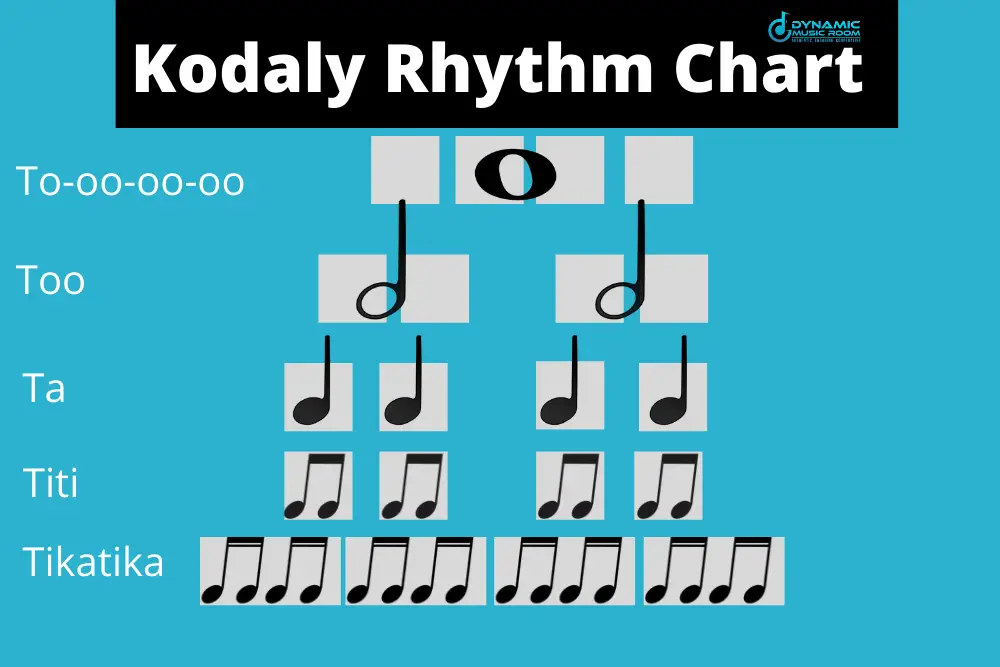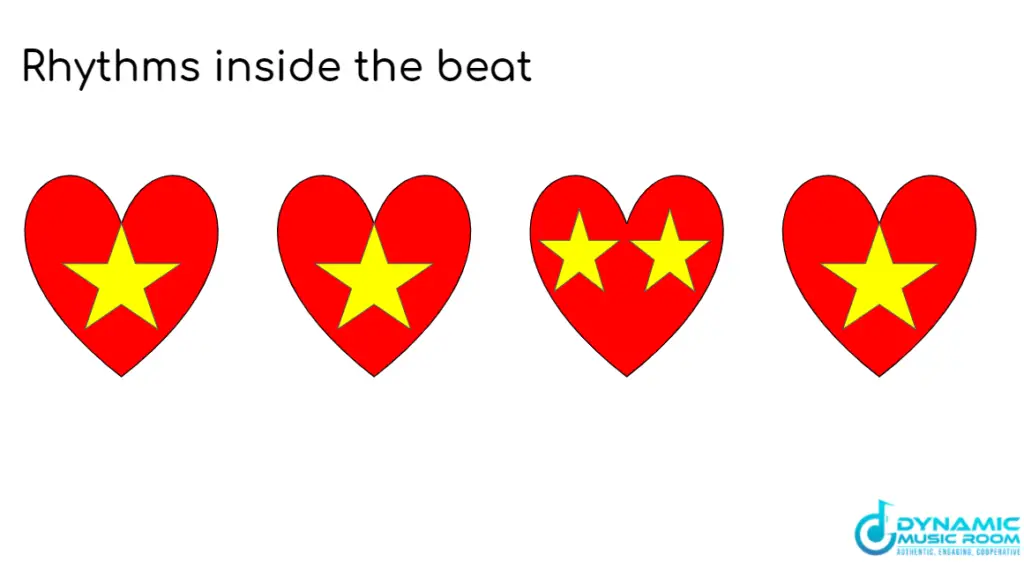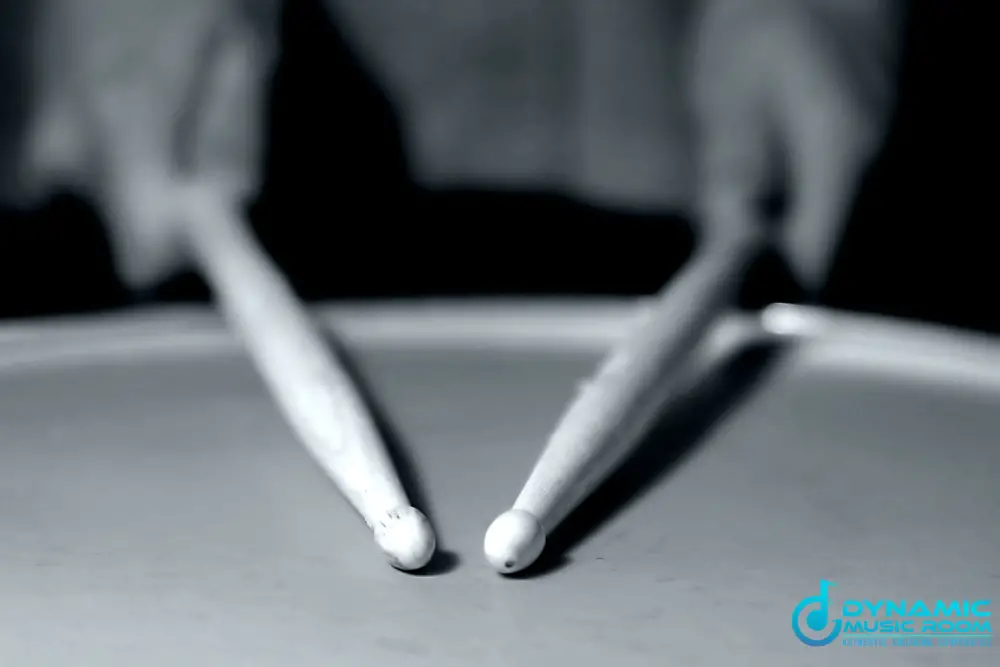Are you searching for an excellent visual to show Kodaly rhythms?
Do you want a visual representation of how these rhythms work?
One of the greatest strengths of the Kodaly method is the rhythms and solfeggio syllables.
Still, most students and people are visual learners, so it’ll help to show them a Kodaly rhythm chart.
A Kodaly rhythm chart will show how the rhythms relate to one another while also showing the rhythm syllables used. Most Kodaly teachers use the Ta and Titi system, but no specific method is required.
Check out the rest of the article for the visuals and more information.
Table of Contents
Kodaly Rhythm Chart
This chart was designed to show rhythms and different ways.
First, it shows how rhythms relate to one another geometrically.
For example, the quarter note is shown being broken down into a pair of eighth notes.
This style of chart has been around for many years.
Students and adults alike see how rhythm sizes are connected.
In particular, I enjoy this type of chart because it allows for easier transfer in the cut time down the road.
Of course, you may never reach cut time in your elementary music classes, and that’s perfectly fine.
To be honest, I only get there sometimes with my fifth graders, and that’s after six years of consistent instruction.
Take a look at the Kodaly rhythm chart below.

Easy Reference
Another useful part of a rhythm chart such as this is how it’s an easy reminder of what syllables belong with what notes.
The chart above follows the traditional Kodaly rhythm syllables that use Ta and Titi.
Despite what some think, Kodaly-inspired teaching does not actually require this rhythm system. In fact, there are many official Kodaly classes that use other systems.
Some music teachers will get into intense debates on which system is the best.
I avoid that entirely.
I believe as long as you are using a system consistently with your students, they will develop a good rhythmic understanding.
Kodaly Beat Chart
A Kodaly beat chart is similar to the rhythm chart.
Most often, it uses blocks or hearts to represent the beat and then place the rhythms or iconic notation.
Beat charts show how the beat doesn’t change, and the rhythms fit inside the beat.
It’s stereotypically Kodaly, and I always make mine in Canva.
Check this example out.

How To Use Kodaly Rhythm Charts
Of course, a chart such as this is nice to show, but there are some ways you may want to actively include it in your classroom.
This section covers three ways I use the rhythm charts for my students.
#1 Facilitating Discussion
OK, this one sounds fancy, but it’s not nearly as complicated as it sounds.
I use the chart often as a way to simply discuss how the rhythms relate to one another.
Usually, I use a cooperative learning structure to break students into small groups and guide discussion on pointed questions.
Click the link to check out more on cooperative learning in music.
One structure that seems to work well it’s called talking chips.
In this structure, you have a small group of three or four.
Each person gets a specified number of chips.
For this activity, I’ll give each student two talking chips.
After each question, students raise their hand in their group and make a comment.
Each comment cost them one chip.
When the chips are gone, that student isn’t allowed to offer a comment.
This ensures all students participate.
Here are some sample questions I use with the rhythm chart:
- How does quarter notes relate to eighth notes?
- How many eighth notes are in a half note?
- Which rhythm has 4 inside a quarter note?
#2 Fill In The Blank
For this one, I cover up the parts of the rhythm chart with a sticky note or block if I’m projecting on a screen.
Students are assigned groups ( I love group work) and given a blank rhythm chart.
From here, they must work together to fill out all of their rhythm charts.
This may seem simple, but when they first do this activity, you’ll be surprised how many kids all of a sudden forget the order of the rhythms.
#3 Create Their Own Rhythm Chart
This activity works best when you’ve already done the other two.
Students, either on their own or in a small group, are tasked with creating their own rhythm chart.
The chart must include rhythms they know and demonstrate how the sides of rhythms are related to one another.
It helps if you model the process of creating a new rhythm chart.
You may also find it helpful to include props or suggestions.
For example, students may use pie or pizza to show rhythm values instead of rectangles like my example does.
Final Thoughts
Kodaly rhythm charts are a must-have for any classroom.
If you’re not using a Kodaly specific chart, I hope you get another one for your room.
If you don’t have a room, consider downloading one anyway and projecting it when you need it.
Rhythms are one of the easiest and most fun musical concepts to teach in elementary music.
There’s nothing wrong with this, and you can enhance instruction by using a visual such as the rhythm chart.

